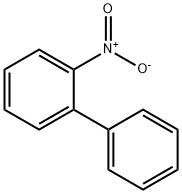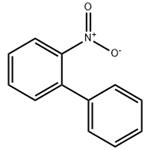Chemical Properties
Clear yellow liquid after melting. Insoluble in water, soluble in methanol, ethanol, acetone, dimethylformamide, and tetrahydrofurfuryl alcohol.
Uses
2-Nitrobiphenyl is used as a plasticizer for resins, cellulose acetate, cellulose nitrate, and polystyrenes; as a fungicide for textiles; as a wood preservative; and as a dye intermediate.
General Description
Gold to tan crystals or brown solid.
Air & Water Reactions
Insoluble in water.
Reactivity Profile
Aromatic nitro compounds, such as 2-Nitrodiphenyl, range from slight to strong oxidizing agents. If mixed with reducing agents, including hydrides, sulfides and nitrides, they may begin a vigorous reaction that culminates in a detonation. The aromatic nitro compounds may explode in the presence of a base such as sodium hydroxide or potassium hydroxide even in the presence of water or organic solvents. The explosive tendencies of aromatic nitro compounds are increased by the presence of multiple nitro groups.
Fire Hazard
2-Nitrodiphenyl is combustible.
Purification Methods
Crystallise it from EtOH (seeding required). Sublime it under vacuum. [Beilstein 5 H 582, 5 I 273, 5 II 487, 5 III 1750.]
References
[1] A. SEKINE. 2-nitrobiphenyl and 2,2’-dinitrobiphenyl[J]. Acta crystallographica. Section C, Crystal structure communications, 1994, 26 1: 1101-1104. DOI:10.1107/S0108270194001009.
[2] YOST Y. Carbazole from o-biphenylhydroxylamine and from 2-nitrobiphenyl and phenylmagnesium bromide[J]. Journal of Heterocyclic Chemistry, 1972, 9 1: 151-152. DOI:10.1002/jhet.5570090128.
[3] EVA HORAKOVA. Voltammetric Determination of 2-Nitrobiphenyl and 4-Nitrobiphenyl Using a Mercury Meniscus Modified Silver Solid Amalgam Electrode[J]. International Journal of Electrochemical Science, 2015, 10 3: Pages 2155-2169. DOI:10.1016/S1452-3981(23)04837-X.
[4] JIRO HIGUCHI. Electron paramagnetic resonance study on the triplet species produced from 2-nitrobiphenyl derivatives by UV irradiation[J]. Journal of Photochemistry and Photobiology A-chemistry, 1999, 124 1: Pages 53-65. DOI:
10.1016/S1010-6030(99)00075-1.



